Plant of the Month: June 2012
|
Edible Elephant-Ear Plants
|
| Alocasia species |
ARACEÆ ; Arum, Aroid, or Skunk Cabbage Family
|
| In my edible houseplant research, a unique ongoing 5-year study, one plant family stands out for its having at least two dozen genera, nearly all of which contain poisonous calcium oxalate crystals. To render such plants safe to eat demands care --just as one must be careful to cook stinging nettles before eating them. The family is the ARACEÆ, commonly called the Arum, Aroid, or Skunk Cabbage Family. Its 24 genera I am studying are as follows --each genus with at least one species eaten by humans, and at least one species cited as worth trying as a houseplant: Acorus, Aglaonema, Alocasia, Amorphophallus, Anthurium, Arum, Caladium, Cercestis, Colocasia, Cyrtosperma, Epipremnum, Homalomena, Monstera, Philodendron, Pistia, Pothos, Scindapsus, Rhaphidophora, Rhodospatha, Schismatoglottis, Spathiphyllum, Syngonium, Xanthosoma, and Zantedeschia. |
| Taro [Colocasia esculenta (L.) Schott] is by far the best known edible aroid, cultivated for over 10,000 years, and a major world staple crop --"the potato of the tropics." The book Edible Aroids edited by Satish Chandra (1984) has much information on it and others. Fortunately, the needle-like calcium oxalate crystals (also called oxalic acid crystals or raphides) in these plants, though insoluble in water, have their acrid, irritating properties reduced much by thorough cooking; fermentation and drying also have been employed in some cases. Calcium oxalate crystals are by no means limited to this family; for example, they are also in rhubarb, spinach, and begonia, too. But with few exceptions, to taste or eat Arum Family plants raw, a person risks serious pain and swelling --in rare cases even death. |
| The Greek-derived generic name Alocasia means in effect NOT Colocasia. The latter genus has fewer species (16 compared to Alocasia having 113 named plus 27 more "in line"), that are more prized for food than as ornamentals. Xanthosoma is the New World analogue of Colocasia and Alocasia; its leaves are also arrowhead shaped, and large, but not peltate, and are thin. Closely related to Xanthosoma, and also New World, is genus Caladium, with over 1,000 named cultivars of flamboyantly colorful leaves. Later, I will write about these genera. |
| As for English names, one in use for several Alocasia is Elephant Ear or Elephant's Ear(s) Plant. That suggestive name has been applied over the years to various other plants, such as: large-leaved Begonia, Caladium, Colocasia, Enterolobium cyclocarpum, Petasites japonicus var. giganteus, Philodendron domesticum, and Xanthosoma. |
| Compared to certain aroid scientists and avid amateurs, I know almost nothing about Alocasia. My goal was to learn which of its species have been reported eaten by humans, can they grow indoors, and are they worth growing? I am indebted to various authors for the information I found, and herewith share with you. Notably, LariAnn Garner's Aroidia Research website (http://aroidiaresearch.org/), and scholarly journal articles by Peter C. Boyce. |
| Alocasia species inhabit the Old World tropics and subtropics: ranging from the E Himalayas throughout subtropical and tropical Asia into the tropical W Pacific and E Australia. The most closely related genus is Colocasia. The main technical distinction between the two genera is Alocasia having few ovules on basal placenta, Colocasia many ovules on parietal placentas. That means utterly nothing to most of us. Plainly seen by people, however, is that Alocasia berries are bird-dispersed (being non-odorous, and usually bright red colored), but mammal-dispersed in Colocasia (smelly fruit, inconspicuously colored). Alocasia species vary from tiny to medium-sized herbs, or rarely treelike and gigantic. |
The three main Alocasia species that have been eaten are elaborated upon below; three additional species are as follows:
|
| Alocasia acuminata Schott |
| Alocasia fornicata (Roxb.) Schott |
Alocasia Portei Schott
|
Various medicinal uses are also made of Alocasia species, but I did not look into this realm.
|
| Alocasia macrorrhizos (L.) G. Don 1839 |
| = Alocasia macrorhiza (L.) Schott |
| = Alocasia indica (Lour.) Spach |
| = Alocasia plumbea Van Houtte |
| = Arum macrorrhizos L. 1753 |
| = Colocasia macrorrhizos (L.) Schott 1832 |
| Giant Taro or 'Ape (pronounced "Ah-pay"). Elephant Ear. |
| Giant, shiny leaves --not prettily veined ones-- mark this species. Only one Alocasia bears larger leaves: Alocasia robusta M. Hotta, with leaves up to 14 feet 9 inches long by 8 feet wide! --the largest undivided leaves known. Usually, Alocasia macrorrhizos leaves are not more than 2 to 6 feet long in northern cultivation, but in the tropics can achieve close to 10 feet long and over 6 feet wide. Boyce reports it is grown from Indo-malesia to Oceania; not clear where, if anywhere, wild (but the Philippines is its likely source originally). It was evidently prehistorically distributed widely in tropical Asia as a subsistence crop. Its starch grains were found on Solomon Island stone tools dated to 27,000 years ago! Now it is pantropical due to its use as an ornamental. It has been, and still is --by far-- the major edible Alocasia, with cultivars selected in Oceania (such as in Samoa and Tonga) for their palatability. Sunset reports that it loses leaves below 29 degrees F, and Plant Delights Nursery says it survives a winter of even 0 degrees F. |
| This species and its cultivar 'Variegata' are in the 2004 book Houseplants by Richard Rosenfeld, but most earlier houseplant books omit it. Elbert's 1989 book Foliage Plants for Decorating Indoors, for example, has 9 Alocasia species, but not this one. Ascribed ornamental cultivars include 'Big Mac', 'Black Stem', 'Borneo Giant', 'Golden', 'Lutea', 'Seven Colors', 'Shock Treatment', 'Solid Gold', 'Storm Warning', 'Variegata', and 'Violacea'. |
Though eaten in various regions, and the most-eaten Alocasia, still overall it is a minor food species. H.M. Burkill writes that it is laborious to get the taro starch from the rootstock, and the return not high, compared to more convenient starchy food-plants. The rootstock must be carefully peeled, cut into pieces, and well cooked before being eaten --too many oxalate crystals to eat raw or lightly cooked. In India, the shoots and leaves also have been cooked, and the fresh stems used in curry. In Indochina, the floral clusters are cooked.
|
| Alocasia odora (Lindl.) K. Koch 1855 |
| = Alocasia odorata hort. |
| = Caladium odorum Lindl. 1822 |
| Giant Upright Elephant-Ears. Night-scented Lily. |
| Vietnamese: Môn bạc hà (the Mint to make soup) or Doc mùng. |
Compared to Alocasia macrorrhizos, this is smaller; less cold-hardy; its flowers are fragrant; its leaves are peltate; and it is well known as a SE Asian vegetable. Its leaf-stalks are peeled, cut into pieces and cooked, often in soups such as Tom-Yum soup or Tamarind soup, or in stir-fry dishes. R.N. Banerjee & Chhabi Ghora wrote that the rhizome is cooked in West Bengal, India. The plant grows 3 to 8 feet tall; its leaf-blade can be 4 feet 3 inches long and 3 feet wide, with a leaf-stalk 5 feet long. Wild from Assam, India, to SW China, SW Cambodia and east to Japan (Ruykyu Is). D.J. Mabberley calls it merely the wild form of Alocasia cucullata. Unlike that species (treated below), it grows larger, is a lighter green, and blooms freely. LariAnn Garner's Aroidia Research reports two main kinds in U.S. cultivation, "Blue Odora" (from Yunnan, China; bluish leaf-stalks; widely available in the trade but usually sold as "Alocasia gigantea") and what she terms "Indian Odora." The specimen I bought from www.floraexotica.ca, for $5 in July 2011, and depict below, appears to be either typical Alocasia odora or the Indian one. Named cultivars include 'Aurea Variegata' and 'Okinawa Silver' (= 'Albo-variegata'). So called Alocasia odora 'California' is really Alocasia Gageana Engl. & K. Krause.
|
| Alocasia cucullata (Lour.) G. Don 1839 |
| Chinese Taro. Chinese 'Ape. Jade Millie Taro. Artist's Wand™ Chinese Taro. Buddha's Palm. |
Cultivated from NE India (Sikkim) south to Sri Lanka and east to Taiwan; only found in association with humans: a domesticated plant derived from Alocasia odora or Alocasia navicularis (K. Koch & C.D. Bouché) K. Koch & C.D. Bouché. It grows about 3 feet tall; leaf-blade shiny, smaller than those of the preceding two species: at most 16 inches long and 12 inches wide, on a leaf-stalk to 36 inches. Fruit is rarely formed. At least in parts of India, its tubers are eaten as vegetable, tasting like potatoes, eaten from November into March. A Tropical Garden Flora (2005) reports it as among the hardiest; its stems can survive frost. Sunset calls it an excellent container plant. It is included in the 2008 book Miracle-Gro® Complete Guide to Houseplants. Cultivars include 'Crinkles', 'Moon Landing' (= 'Variegata') and 'Yellow Tail'.
|
| All three of these Alocasia species bear plain green leaves (except in certain cultivars). Many other species and hybrids flaunt boldly colorful patterns. Best known is variously called the African Mask, Jewel Alocasia, Alocasia Alligator, Alocasia Polly --correctly Poly Alocasia. It has showy white veins. Two other of many Alocasia hybrids include 'Calidora' and 'Hilo Beauty'. A strikingly dark species is Alocasia reginula A. Hay 1998, the Black Velvet Alocasia. A cold-hardy species is Alocasia Wentii Engl. & K. Krause. It is these latter species and hybrids that are most likely to be grown in the U.S. for ornament, either as houseplants or outside in warm regions. They mostly are smaller than the three species I singled out above, and that fact, plus their foliage beauty, makes them more suitable as ornamentals. |
| All Alocasia thrive best in warm and humid atmosphere such as a greenhouse. It is best if they are kept at 65 degrees F or higher, and 60% or higher humidity. If they live and grow, most require much space, and watering. Whereas their food value is relatively low, and not easily prepared, and their cultural needs not readily met in most buildings, therefore their main role is clearly ornamental --their bold, tropical foliage is dramatically exciting. |
| In the case of my houseplant Alocasia odora, I kept it warm, protected from full sun, and sufficiently watered and fertilized that it grew. After it had grown nearly a year, I was hopeful that any pesticide residues were likely broken down, so I could safely try cooking it. I cut off three leaves, peeled the leaf-stalks (a bother), chopped them, and fried them in peanut oil with a bit of fish sauce. After a while, I added broccoli, toasted black sesame seeds, and spicy jalapeño refried beans to the pan, and cooked onward. The final dish tasted acceptable, but no particular Alocasia flavor came through. Even if an East Asian chef had prepared a savory dish using my plant, I still shall part with my Alocasia odora --maybe a Seattle Vietnamese restaurant will like it-- and use its place to grow something more desirable in terms of production, nutrition, and ease. |
If you are inclined to experiment with Alocasia in the kitchen, use caution: even the plant sap may cause discomfiture to some people coming in contact with it. Wear gloves; cook a long time; taste a bit to see if you get an adverse reaction.
Back |
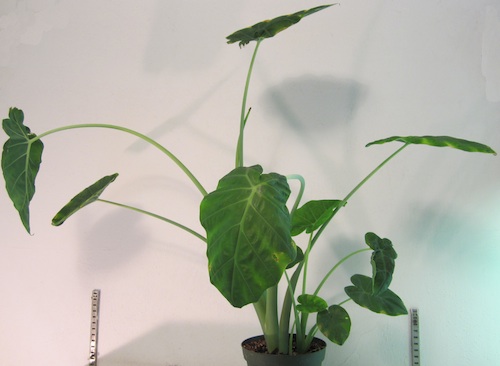
Alocasia odora inside; photo by ALJ
|
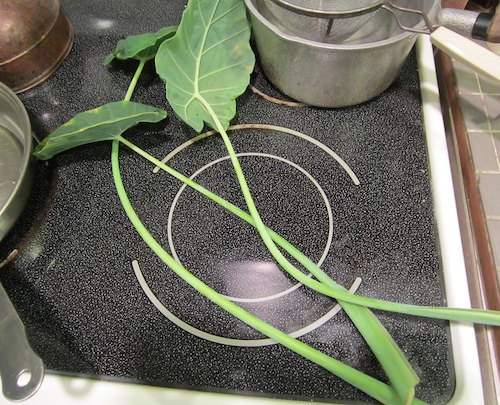
Alocasia odora leaves on stove; photo by ALJ
|
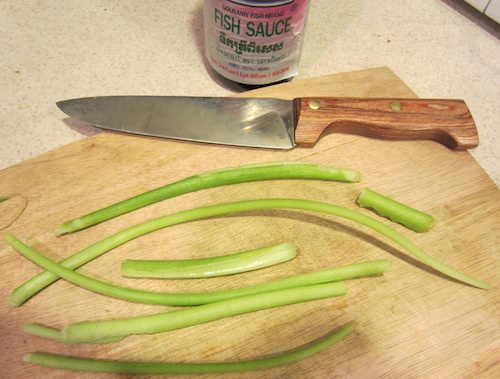
Alocasia odora peeled leaf-stalks; photo by ALJ
|
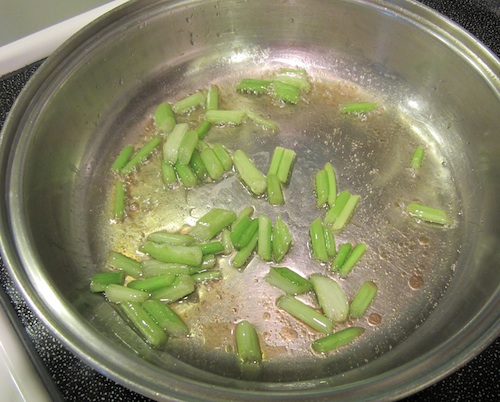
Alocasia odora frying; photo by ALJ
|
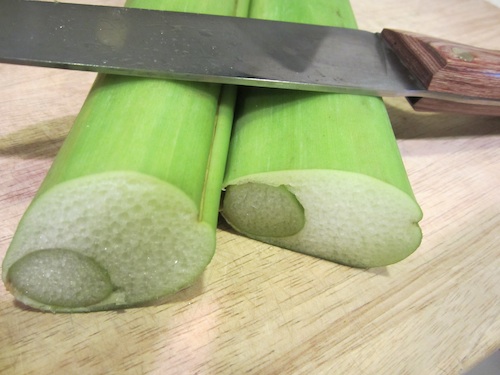
Alocasia odora store-bought leaf-stalks; photo by ALJ
|
|
|

